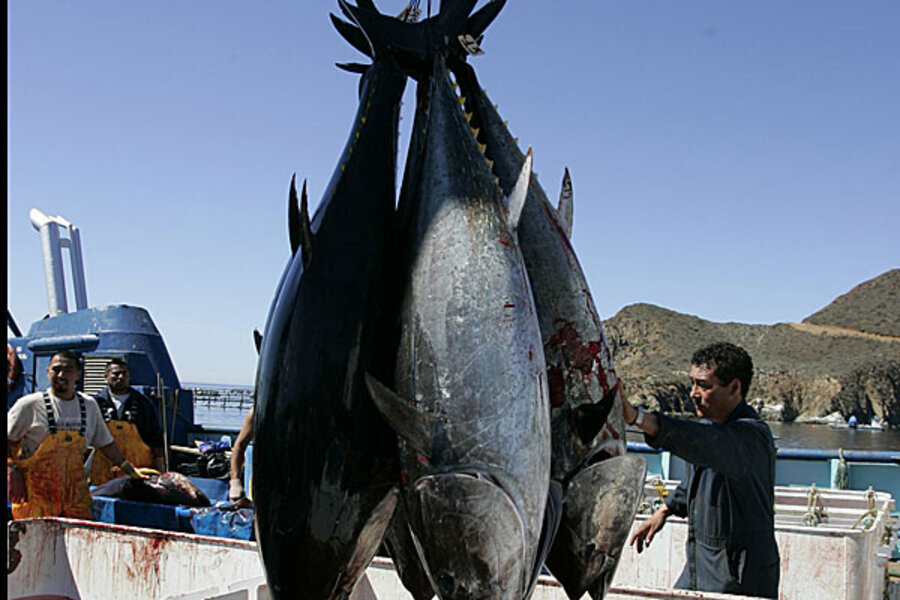Radioactive tuna travels from Japan to US faster than wind
Loading...
| Washingtno
Low levels of nuclear radiation from the tsunami-damaged Fukushima power plant have turned up in bluefin tuna off the California coast, suggesting that these fish carried radioactive compounds across the Pacific Ocean faster than wind or water can.
Small amounts of cesium-137 and cesium-134 were detected in 15 tuna caught near San Diego in August 2011, about four months after these chemicals were released into the water off Japan's east coast, scientists reported on Monday.
That is months earlier than wind and water currents brought debris from the plant to waters off Alaska and the U.S. Pacific Northwest.
RECOMMENDED: Are you scientifically literate? Take the quiz
The amount of radioactive cesium in the fish is not thought to be damaging to people if consumed, the researchers said in a study published in the journal Proceedings of the National Academy of Sciences.
Without making a definitive judgment on the safety of the fish, lead author Daniel Madigan of Stanford University's Hopkins Marine Station noted that the amount of radioactive material detected was far less than the Japanese safety limit.
"I wouldn't tell anyone what's safe to eat or what's not safe to eat," Madigan said in a telephone interview. "It's become clear that some people feel that any amount of radioactivity, in their minds, is bad and they'd like to avoid it. But compared to what's there naturally ... and what's established as safety limits, it's not a large amount at all."
He said the scientists found elevated levels of two radioactive isotopes of the element cesium: cesium 137, which was present in the eastern Pacific before the
Fukushima Daiichi disaster in the spring of 2011; and cesium 134, which is produced only by human activities and was not present before the earthquake and tsunami hit the Japanese plant.
Because cesium 134 is generated only by human activities - nuclear power plants and weapons - and there was none in the Pacific for several years before the Fukushima accident, they reckoned that any cesium 134 they found in tuna off California had to come from Fukushima.
SWIMMING THROUGH CESIUM
There was about five times the background amount of cesium 137 in the bluefin tuna they tested, but that is still a tiny quantity, Madigan said: 5 becquerels instead of 1 becquerel. (It takes 37 billion becquerels to equal 1 curie; for context, a pound of uranium-238 has 0.00015 curies of radioactivity, so one becquerel would be a truly miniscule proportion.)
The researchers figured that the elevated levels of cesium 137 and all of the cesium 134 they detected came from Fukushima because of the way bluefin tuna migrate across the Pacific.
Bluefin tuna spawn only in the western Pacific, off the coasts of Japan and the Philippines. As young fish, some migrate east to the California coast, where upwelling ocean water brings lots of food for them and their prey. They get to these waters as juveniles or adolescents, and remain there, fattening up.
Judging by the size of the bluefin tuna they sampled - they averaged about 15 pounds (6 kg) - the researchers knew these were young fish that had left Japanese water about a month after the accident.
Most of the radiation was released over a few days in April 2011, and unlike some other compounds, radioactive cesium does not quickly sink to the sea bottom but remains dispersed in the water column, from the surface to the ocean floor.
Fish can swim right through it, ingesting it through their gills, by taking in seawater or by eating organisms that have already taken it in, Madigan said.
Bluefin tuna typically have low levels of naturally occurring radioactive material, such as potassium 40, which was present in the world's oceans long before human beings walked the Earth.
Compared to these natural levels of radioactivity, the amount contributed by Fukushima raised the level about 3 percent, Madigan said.
He said there were probably much higher levels of cesium 134 present in bluefin tuna off Japan soon after the accident, as much as 40 to 50 percent higherthan normal. Cesium 134 decays quickly, with a half-life of two years. Bluefin tuna excrete it on a daily basis and it also gets diluted in their bodies as they grow.
(Reporting By Deborah Zabarenko, Environment Correspondent; Editing by Philip Barbara)





